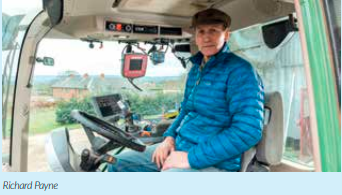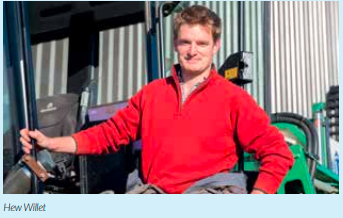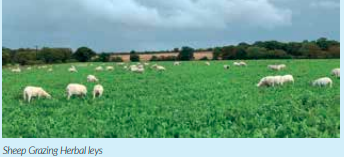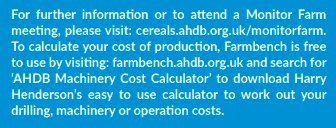Evolution or revolution? Two AHDB Monitor Farmers (Richard Payne and Hew Willett) tell their story of their
journey to direct drilling, with an introduction from Harry Henderson, AHDB

There was once a time when establishing a cereal crop was a straightforward standard process. Bale or burn the straw, subsoil if necessary, plough press, power harrow, and set in with the trusty Massey Ferguson 30 drill and roll. Then burning is banned, power harrowing became expensive and ploughing slow. Worries about where all the straw was going to go came and went, with incorporation being the buzzword. Today, the cost of establishing a cereal crop causes more thoughts turning towards leaving the straw exactly where it is. At many of the Monitor Farm meetings, machinery costs have been dissected in particular crop establishment costs and, these days, personnel objectives, management capacity and soil type play an important role in setting an establishment system on your farm.
Simple, it isn’t; individual to each farm, definitely! But when establishment costs were calculated at our winter Monitor Farm meetings and put up on a flip chart, costs ranged from a John Deere 6150R pulling a 4-metre 750a no-till drill for £19/ ha through to 6-metre Kverneland TS Evo tine drill, pulled by a John Deere 6920S at £43/ha. The greatest impact of cost tends to be the area covered by the system not the system type itself; so don’t dismiss investigating the change. Here are two of our Monitor Farmers, Hew Willett, Chelmsford Monitor Farm, and Richard Payne, Taunton Monitor Farm, with their own thoughts on how they have aimed to reduce soil movement and costs.
Case Study 1: Richard Payne, AHDB Taunton Monitor Farmer

Richard farms 267 hectares near Taunton on predominantly silty clay loam soils. The pathway to reducing cultivations began 25 years ago when the last ploughing was done, originally driven by pressures on labour and time. Since then, there has been a gradually reduced investment in steel and soil movement. Except rape straw and bean haulm, all straw is baled and sold.
Richard says, “originally, ploughing was followed by a SKH Crumbler, then power harrow/combination drill and rolling. First to go was the power harrow/drill, with ploughing followed by a Freeflow drill. After the plough was sold, soil movement was with Simba 2B discs and trailed double press, before the Freeflow. In 1998, a Vaderstad Carrier, used in conjunction with a McConnel Shakaerator, became the core system. Then a Sumo Trio replaced the Shakaerator. The Vaderstad Carrier still normally followed the Sumo in dry conditions and for second wheats as the sole cultivation, now that the soils are so good. Drill choice has changed, too, over the years. A switch was made to a Vaderstad Rapid drill in 2000 and then to a Horsch Sprinter tine drill in 2013. This is now in its sixth season. I have since increased its flexibility by switching to Bourgault Versatile Opener System (VOS) low disturbance points. Rolling is carried out whenever possible after drilling.
What have the challenges been over the years? None! And this is down to making the change a gradual one. Now, improved soil structure retains moisture better, allows increased timeliness of operations and provides potential for higher margins.
“What have the challenges been over the years? None! And this is down to making the change a gradual one.”
My objective now is to better understand the soil science, move even less soil and do even more direct drilling. For harvest 2019, half of the rape area was direct drilled. Drilling has been less successful for 2020 harvest but I do not put that down to the system. A greater understanding of the costs of production has made me realise how little margin there is to play with and, hence, reducing cultivations is key. However, I want to achieve this with the flexibility of the existing machinery rather than reinvest. This will also help work with changes in political and public sentiment towards less subsidised, more integrated environmental farming and carbon management. These are likely to be new drivers for change for me, as well as climate pressure and the underlying economics of crop production in this country.
Case Study 2: Hew Willett: Making Change
Ten years ago, as a student studying for A Levels, long hours in a tractor seat were something to boast of. Fast forward a decade and I’m now actively trying to stay out of the tractor as much as possible. Knowing exactly how much it is costing for each operation (insert AHDB Farmbench promo here), certainly focuses the mind and makes you question the reasons for trundling up and down the field ad nauseum.

Increasing operation costs was certainly a key part of the decision to move away from a plough-press-based system to strip-till in 2015, but I would say that soil health was a far greater motive behind the switch. That year saw the purchase of a 4 metre Mzuri drill. No machinery was sold immediately, and there was still a fair proportion of the farm put to the plough that year. However, after our first ‘Mzuri’ harvest, our confidence and, more importantly, our knowledge increased so that, the following year, our strip-till area was on the increase. With the strip-till concept having proved itself, we had the confidence to start disposing of machinery that was doing nothing except depreciating!
Four years later, we are three cultivators, one plough, one subsoiler, one tractor and one drill lighter. We are now running two 180 horsepower tractors, a 6 metre Sly disc drill, a Horsh CO4 with Dutch openers, a stubble rake and a set of rolls for our crop establishment. The lighter tractor weight has certainly been a benefit this autumn, with damage on the headlands significantly lower than had we been running the previous heavier machine.

Although for us autumn 2019 has not been the season for a zero till disc drill, we have drilled some wheat into a good seedbed with the Horsch; the good soil structure has enabled us to travel without fearing of getting stuck and, moreover, risked less than £30/ha doing so.
“Four years later, we are three cultivators, one plough, one subsoiler, one tractor and one drill lighter.”
In hindsight, would we have bypassed the strip-till and gone directly to zero till? The figures would suggest, yes – there was certainly a high depreciation cost with owning a drill for just four years. However, it has taken a lot of learning and a complete mindset change, not just about establishment, but the whole farming system, to get to where we are now. Five years ago, I would have laughed if you said that we would have our own sheep grazing herbal leys and cover crops, or would no longer be using insecticides or seed dressings. This process has been fast-tracked by being Monitor Farmers, requiring us to research and justify the decisions we are taking. Without those years of learning, we may have had one too many failures had we not had the ‘safety net’ of the strip-till machine, and I might have been reading this sat on a tractor instead of writing it sat at home!

